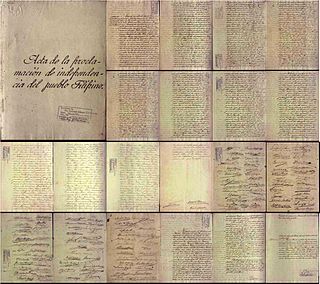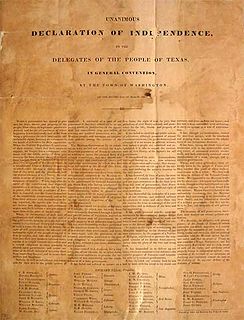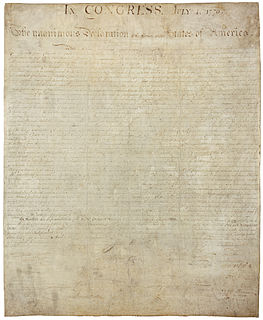A declaration of independence or declaration of statehood is an assertion by a defined territory that it is independent and constitutes a state. Such places are usually declared from part or all of the territory of another nation or failed nation, or are breakaway territories from within the larger state. In 2010, the UN's International Court of Justice ruled in an advisory opinion in Kosovo that "International law contains no prohibition on declarations of independence", though the state from which the territory wishes to secede may regard the declaration as rebellion, which may lead to a war of independence or a constitutional settlement to resolve the crisis.

The Texas Declaration of Independence was the formal declaration of independence of the Republic of Texas from Mexico in the Texas Revolution. It was adopted at the Convention of 1836 at Washington-on-the-Brazos on March 2, 1836, and formally signed the next day after mistakes were noted in the text.

Coxsackie B is a group of six serotypes of Coxsackievirus, a pathogenic enterovirus, that trigger illness ranging from gastrointestinal distress to full-fledged pericarditis and myocarditis.

The Mecklenburg Declaration of Independence is a text published in 1819 with the claim that it was the first declaration of independence made in the Thirteen Colonies during the American Revolution. It was supposedly signed on May 20, 1775, in Charlotte, North Carolina, by a committee of citizens of Mecklenburg County, who declared independence from Great Britain after hearing of the battle of Lexington. If the story is true, the Mecklenburg Declaration preceded the United States Declaration of Independence by more than a year. The authenticity of the Mecklenburg Declaration has been disputed since it was published, forty-four years after it was reputedly written. There is no verifiable evidence to confirm the original document's existence and no reference to it has been found in extant newspapers from 1775.

Independence Day is a federal holiday in the United States commemorating the Declaration of Independence of the United States, on July 4, 1776. The Continental Congress declared that the thirteen American colonies were no longer subject to the monarch of Britain and were now united, free, and independent states. The Congress had voted to declare independence two days earlier, on July 2, but it was not declared until July 4.

The Philippine Declaration of Independence was proclaimed on 12 June 1898 in Cavite II el Viejo, Philippines. With the public reading of the Act of the Proclamation of Independence of the Filipino People, Filipino revolutionary forces under General Emilio Aguinaldo proclaimed the sovereignty and independence of the Philippine Islands from the colonial rule of Spain.

The Syng inkstand is a silver inkstand used during the signing of the United States Declaration of Independence in 1776 and the United States Constitution in 1787. It is one of four objects still existing that were present during the Constitutional Convention, along with Independence Hall itself, the Liberty Bell, and the chair that George Washington sat in as the Constitutional Convention's presiding officer.

The Committee of Five of the Second Continental Congress was a group of five members who drafted and presented to the full Congress what would become America's Declaration of Independence of July 4, 1776. This Declaration committee operated from June 11, 1776, until July 5, 1776, the day on which the Declaration was published.

Texas Independence Day is the celebration of the adoption of the Texas Declaration of Independence on March 2, 1836. With this document signed by 59 delegates, settlers in Mexican Texas officially declared independence from Mexico and created the Republic of Texas.

Declaration of Independence is a 12-by-18-foot oil-on-canvas painting by American John Trumbull depicting the presentation of the draft of the Declaration of Independence to Congress. It was based on a much smaller version of the same scene, presently held by the Yale University Art Gallery. Trumbull painted many of the figures in the picture from life, and visited Independence Hall to depict the chamber where the Second Continental Congress met. The oil-on-canvas work was commissioned in 1817, purchased in 1819, and placed in the United States Capitol rotunda in 1826.
The Declaration of Independence of the Republic of Moldova was a document adopted on 27 August 1991 by the Parliament of the Republic of Moldova following the failure of the August coup attempt.

The United States Declaration of Independence, which announced that the thirteen American colonies then at war with Great Britain were no longer a part of the British Empire, exists in a number of drafts, handwritten copies, and published broadsides.
Coxsackie Creek is a 9.8-mile-long (15.8 km) tributary to the Hudson River in the towns of Coxsackie and New Baltimore, New York in the United States.

The signing of the United States Declaration of Independence occurred primarily on August 2, 1776 at the Pennsylvania State House, Independence Hall in Philadelphia, Pennsylvania. The 56 delegates to the Second Continental Congress represented the 13 former colonies which had declared themselves the "United States of America," and they endorsed the Declaration of Independence which the Congress had approved on July 4, 1776. The Declaration proclaimed that the former Thirteen Colonies then at war with Great Britain were now a sovereign, independent nation and thus no longer a part of the British Empire. The signers’ names are grouped by state, with the exception of President of the Continental Congress John Hancock; the states are arranged geographically from south to north, with Button Gwinnett from Georgia first, and Matthew Thornton from New Hampshire last.

The Memorial to the 56 Signers of the Declaration of Independence is a memorial depicting the signatures of the original 56 signatories to the United States Declaration of Independence. It is located in the Constitution Gardens on the National Mall in Washington, D.C. The memorial is accessible to the public by crossing a wooden bridge onto a small island set in the lake between Constitution Avenue and the Reflecting Pool, not far from the Vietnam Veterans Memorial.

The Catalan declaration of independence was a resolution that was passed by the Parliament of Catalonia on 27 October 2017, which declared the independence of Catalonia from Spain and the founding of an independent Catalan Republic. The declaration did not receive recognition from the international community.














